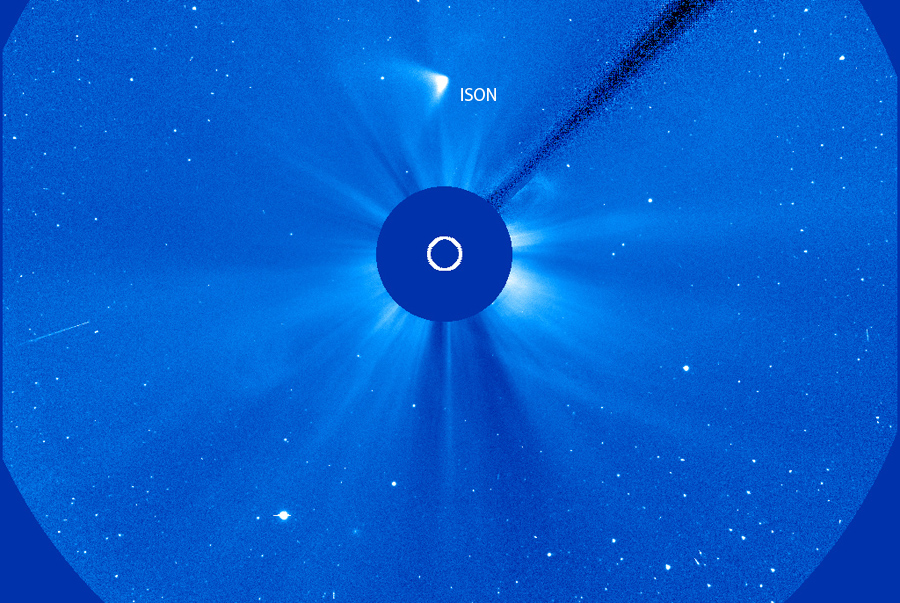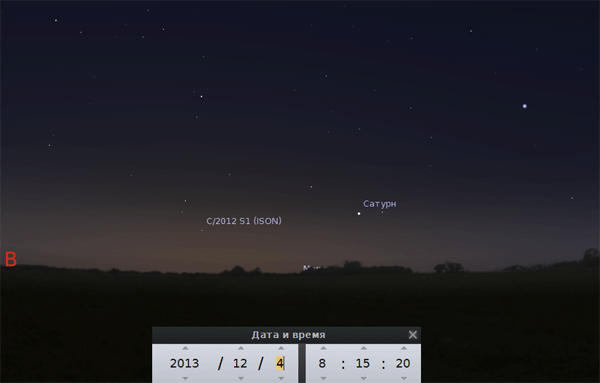Comet ISON: Results of the Meeting with the Sun
The meeting with our luminary was hard at ISON. But she partially survived it, although it was fragmented.

Judging by the pictures from NASA and ESA solar observatories, the comet has experienced two stages of crushing. The first one was recorded on November 28 at about 13:00 Moscow time. The comet, on approaching the Sun, sharply reduced its brightness. This means that the kernel has lost its integrity. Apparently this is due to the actions of tidal forces from the increase in the gravitational influence of the Sun.

')
Around 22:00 Moscow time, having come close to the luminary for almost a minimum distance of 1.1 million km, ISON experienced another stage of fragmentation, which was accompanied by the release of large clouds of gas and dust. Difficult minutes for a comet are noticeable at the SDO observatory frame:

Here, most likely, the temperature of the sun played a decisive role. The solar wind knocked the comet's tail and it almost disappeared in the crown. However, after a couple of hours, observers who kept the SOHO observatory server under siege examined a small fragment of a comet that had slipped through the thick:
Now it is moving away from the Sun and slowly gaining brightness. It is true that until she reached even the value that the comet had on approach:
ISON is usually compared to another lovejoy near-solar comet. Tu was also prematurely buried, however, despite the 500-meter core (ISON has 2 km), she survived the meeting with the Sun and later “inflamed” unexpectedly strongly, giving an unforgettable sight to the inhabitants of the southern hemisphere in 2011.

But there are significant differences in the behavior of these two comets in the Sun:
It can be seen that, unlike ISON, Lovejoy did not break up, and very slowly grew its tail:
ISON also began to "smoke" almost immediately after leaving the crown. This may mean that the group of debris that the comet has become has a larger area of evaporation, therefore losing more gas and dust.
It’s difficult to say how a reborn comet will behave further. However, we can assume that we have a small chance to see her in December in the sky. Perhaps it will not be distinguishable with the naked eye, but when taking pictures with a long exposure or observing with binoculars or a telescope, you can see it. The closest approach to the Earth will take place on December 25-26. However, it will fly at a distance of 65 million kilometers - sometimes Mars flies closer - therefore neither it, nor its fragments, nor its tail are dangerous for the Earth.
It will be possible to try to observe it in about a week, when ISON moves away from the Sun. Now it is necessary to search in the mornings, a little to the left of the luminary, and, naturally, before sunrise:

After December 15, in the evening you can try to see it in the west at the horizon.
It should be borne in mind that, although ISON is now moving closer to the Earth, it is moving away from the Sun and its brightness will fall. Therefore, it is better to try to look at it at the beginning of December, not postponing it by the New Year.

Judging by the pictures from NASA and ESA solar observatories, the comet has experienced two stages of crushing. The first one was recorded on November 28 at about 13:00 Moscow time. The comet, on approaching the Sun, sharply reduced its brightness. This means that the kernel has lost its integrity. Apparently this is due to the actions of tidal forces from the increase in the gravitational influence of the Sun.

')
Around 22:00 Moscow time, having come close to the luminary for almost a minimum distance of 1.1 million km, ISON experienced another stage of fragmentation, which was accompanied by the release of large clouds of gas and dust. Difficult minutes for a comet are noticeable at the SDO observatory frame:

Here, most likely, the temperature of the sun played a decisive role. The solar wind knocked the comet's tail and it almost disappeared in the crown. However, after a couple of hours, observers who kept the SOHO observatory server under siege examined a small fragment of a comet that had slipped through the thick:
Now it is moving away from the Sun and slowly gaining brightness. It is true that until she reached even the value that the comet had on approach:
ISON is usually compared to another lovejoy near-solar comet. Tu was also prematurely buried, however, despite the 500-meter core (ISON has 2 km), she survived the meeting with the Sun and later “inflamed” unexpectedly strongly, giving an unforgettable sight to the inhabitants of the southern hemisphere in 2011.

But there are significant differences in the behavior of these two comets in the Sun:
It can be seen that, unlike ISON, Lovejoy did not break up, and very slowly grew its tail:
ISON also began to "smoke" almost immediately after leaving the crown. This may mean that the group of debris that the comet has become has a larger area of evaporation, therefore losing more gas and dust.
It’s difficult to say how a reborn comet will behave further. However, we can assume that we have a small chance to see her in December in the sky. Perhaps it will not be distinguishable with the naked eye, but when taking pictures with a long exposure or observing with binoculars or a telescope, you can see it. The closest approach to the Earth will take place on December 25-26. However, it will fly at a distance of 65 million kilometers - sometimes Mars flies closer - therefore neither it, nor its fragments, nor its tail are dangerous for the Earth.
It will be possible to try to observe it in about a week, when ISON moves away from the Sun. Now it is necessary to search in the mornings, a little to the left of the luminary, and, naturally, before sunrise:

After December 15, in the evening you can try to see it in the west at the horizon.
It should be borne in mind that, although ISON is now moving closer to the Earth, it is moving away from the Sun and its brightness will fall. Therefore, it is better to try to look at it at the beginning of December, not postponing it by the New Year.
Source: https://habr.com/ru/post/204158/
All Articles